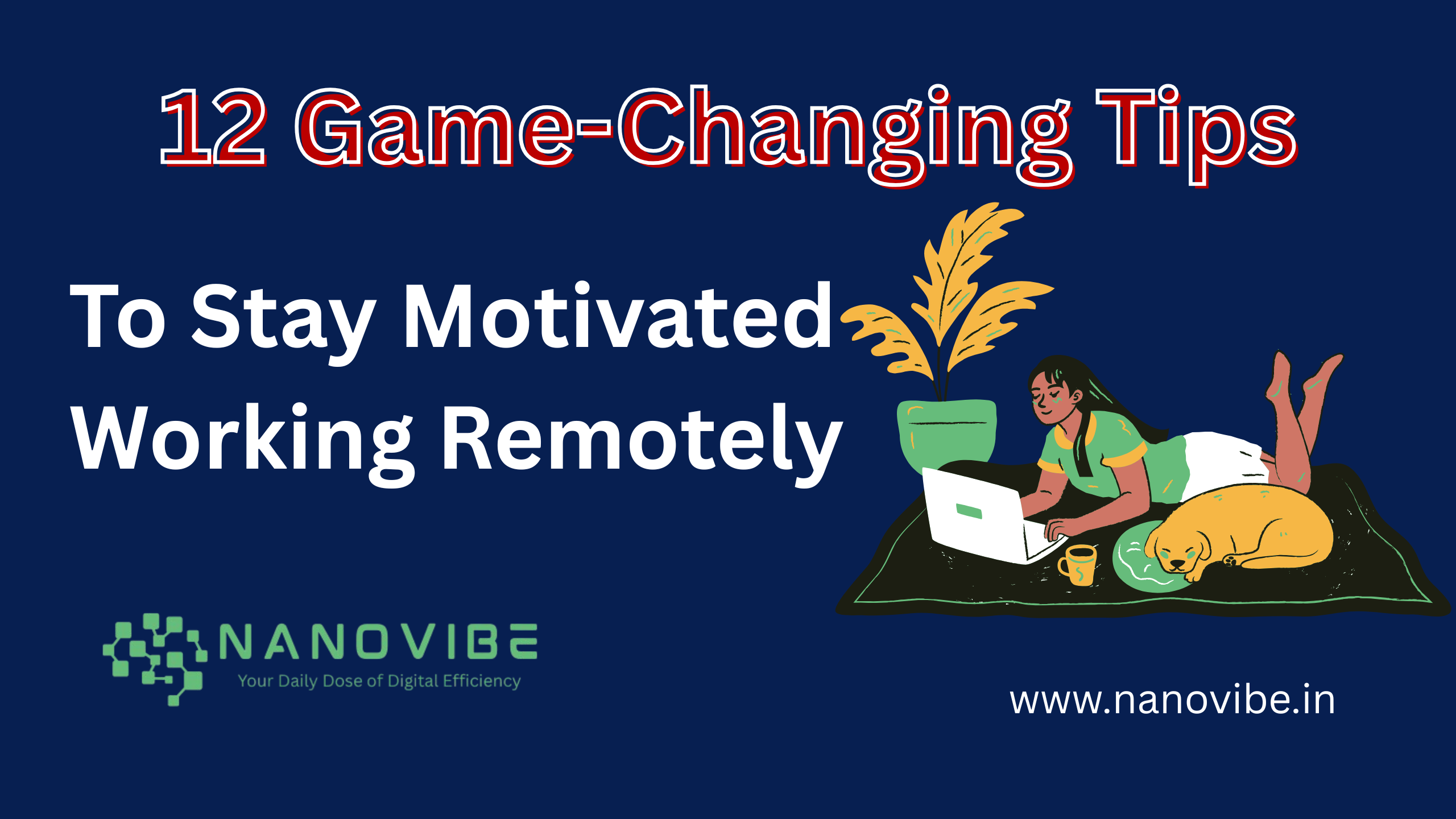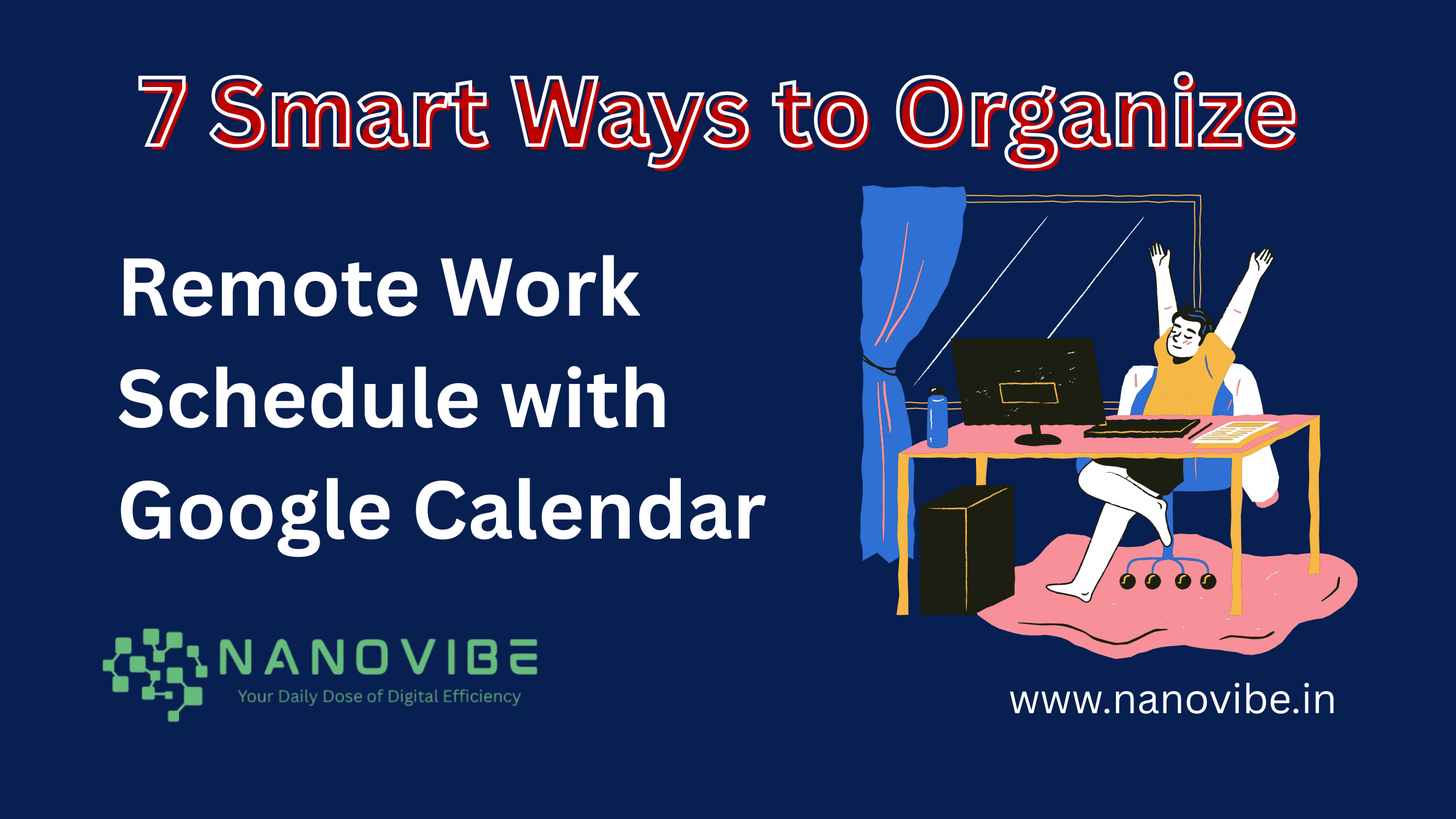Working from home has become the new normal for millions of professionals across the globe. Whether you’re freelancing, running your own business, or clocking in for a remote 9-to-5 job, the flexibility and freedom sound ideal until you realize how hard it can be to stay motivated consistently. If you’ve been searching for how to stay motivated when working from home full-time, you’re not alone.
Unlike traditional office setups where deadlines, meetings, and peer accountability help drive productivity, remote workers often face the challenge of staying focused in a space that was never designed for work. This shift in environment creates a need for practical tips to stay motivated working from home, especially when distractions are just a room away.
The truth is, remote work success goes beyond having a fast Wi-Fi connection and a decent desk setup. It requires mental discipline, intentional daily habits, and a strong understanding of what personally keeps you driven. If you’ve been wondering how to stay motivated working remotely without burning out, this guide will help you build that foundation.
Whether you’re experiencing low energy, difficulty concentrating, or simply lack the inspiration to push through your day, learning effective ways to stay productive while working from home can make all the difference. With the right mindset, strategies, and tools, your home can become a place where motivation thrives not just where work gets done.
This guide isn’t about quick fixes. It’s about understanding the psychology of motivation in a remote setting and learning sustainable strategies that align with your lifestyle, energy patterns, and personal goals. Whether you’re freelancing from your living room or attending Zoom meetings in your kitchen, the following insights will help you rebuild structure, stay focused, and reignite your drive day after day.
How to Stay Motivated When Working from Home: A Practical Guide for Remote Professionals

Remote work has evolved from a temporary fix to a permanent shift in how we live and work. For many, it’s a dream come true freedom from traffic jams, the comfort of home, and more autonomy. Yet for all its perks, remote work also comes with its unique set of challenges, particularly when it comes to motivation. If you’ve found yourself asking, “How to stay motivated working remotely?” you’re not alone.
This guide is designed specifically for remote professionals like you. We’ll explore actionable tips, psychological insights, expert opinions, and real data to help you stay energized and productive while working from home.
Also Read: 7 Elements Every Daily Schedule for Remote Workers Should Include
Impact Factors on Remote Motivation
| Factor | Impact on Motivation | Supporting Stat |
|---|---|---|
| Lack of routine | ↓ 20% productivity | HBR Study, 2023 |
| Dedicated workspace | ↑ 50% motivation | Stanford Remote Work Study |
| Ergonomic environment | ↑ 17% satisfaction | Stanford Research |
| Wellness & mental health care | ↑ 2x Monday motivation | Mental Health America, 2024 |
| Time-blocking tools | ↑ 27% task focus | Survey of remote tech workers, 2023 |
While remote work offers freedom and flexibility, the factors that influence motivation in a home-based setting are uniquely complex and often invisible until performance begins to decline. Understanding these drivers can help remote professionals make targeted improvements rather than generic productivity tweaks.
🕹️ Autonomy Without Direction
One of the biggest hidden challenges is the paradox of autonomy. Remote workers often enjoy more freedom over their schedule but without a clear sense of direction, that freedom can feel overwhelming. Too many choices about when and how to work can lead to decision fatigue, hesitation, and ultimately, reduced drive.
Unlike traditional office environments where workflow is influenced by external cues deadlines, coworkers, and meetings remote professionals must become their own managers, motivators, and schedulers. Without self-imposed clarity, motivation tends to drift.
🌐 Digital Overload and Context Switching
A less obvious but increasingly harmful factor is digital context switching. Jumping between Slack notifications, emails, Zoom calls, and project dashboards can fragment attention and lead to what’s known as “mental residue” the leftover cognitive load from unfinished tasks.
Remote workers, on average, switch between tools and tasks more than 1,200 times a day, according to a study by Rescue-time. This fragmented focus doesn’t just reduce productivity it erodes motivation by making progress feel less tangible and more scattered.
🎯 Lack of Micro-Goals and Feedback Loops
In-office work often includes small wins: impromptu praise, casual check-ins, or progress milestones. At home, without that built-in feedback loop, remote workers can feel like they’re spinning their wheels, even when they’re getting things done.
The absence of clear micro-goals small, trackable wins that reinforce progress can sap motivation quietly over time. When everything feels like one long, uninterrupted project, momentum stalls. That’s why intentional goal-setting and regular review points (daily or weekly) are essential to maintain energy and purpose in remote settings.
🌿 Environmental Stagnation
Unlike a changing office environment where movement is built into the day (commuting, meeting rooms, walking to lunch), remote work can lead to environmental monotony. Staying in the same physical space for hours, days, and weeks on end can dull mental alertness and reduce inspiration.
Studies in behavioral psychology show that even minor environmental changes like shifting your desk position, adding natural light, or taking walking meetings can reactivate motivation by triggering fresh sensory stimulation and breaking routine fatigue.
The Motivation Dilemma in Remote Work

A 2023 report by Buffer on the State of Remote Work revealed that 49% of remote workers struggle with staying motivated, especially when facing isolation, distractions, and blurred work-life boundaries.
At first glance, working remotely seems like a productivity dream: no commute, flexible hours, and complete control over your schedule. But beneath the surface, a motivation crisis is quietly growing in home offices around the world and it’s affecting more people than most employers realize.
Unlike traditional office settings that offer built-in structure, passive social pressure, and visual cues of progress (like seeing coworkers hustle or managers walking by), remote work removes those external motivators entirely. You’re no longer feeding off the energy of a buzzing workplace you’re creating that energy yourself, in silence.
Isolation Is a Motivation Killer
One of the most overlooked obstacles to remote motivation is isolation. It’s not just about missing watercooler chats or Friday lunches it’s about missing consistent human interaction that sparks drive and accountability. When you’re not seen or heard, it’s easy to feel like your work exists in a vacuum. Over time, that can dull your sense of purpose.
Unlike office culture, where feedback, recognition, or even casual validation helps fuel momentum, many remote workers go weeks without hearing a simple “good job.” That lack of acknowledgment slowly erodes internal motivation even for high performers.
Also Read: 7 Smart Ways to Organize Remote Work Schedule with Google Calendar
Time Feels Different at Home
Another subtle but serious issue: the distortion of time. In a remote setup, where personal and professional life blend together, time often loses structure. There’s no clear start or end to the workday, and without boundaries, the brain can’t switch into “focus mode” or “rest mode” effectively.
This mental blur leads to procrastination, task fatigue, and even imposter syndrome especially when to-do lists pile up but nothing feels “done enough.” It’s not a time management problem; it’s a motivation management problem.
Small Setbacks Feel Bigger
In the office, if a project stalls or a client meeting doesn’t go as planned, you’re surrounded by teammates who can help shift your mindset. But at home, even small failures can feel amplified. Without quick access to emotional support or collective brainstorming, remote workers are more likely to internalize stress, which compounds and kills motivation over time.
Routines Lose Their Meaning
Many people try to fix their lack of motivation by building a daily routine. But routines alone aren’t always the answer. When every day looks the same and every task blurs into the next, even a structured schedule can become mentally numbing. The motivation dilemma in remote work is not just about having a routine it’s about having a routine with purpose, flexibility, and flow.
Actionable Tips on How to Stay Motivated While Working Remotely
Staying motivated while working from home is not just about willpower it’s about creating a system that sets you up for daily wins. Whether you’re feeling mentally drained, emotionally disconnected, or simply stuck in a rut, the right changes to your habits and environment can restore your drive and help you get back on track.
If you’ve been searching for how to stay motivated working remotely and keep your energy consistent throughout the week, you’re in the right place. The following tips aren’t one-size-fits-all productivity clichés they’re practical, psychology-backed, and real-world tested strategies used by remote workers who have turned their homes into high-performance zones.
From small behavioral shifts to powerful mindset tweaks, these 10 methods are designed to help you reclaim your focus, structure your day, and feel more accomplished by the time you log off. Let’s dive in with the very first and most foundational step.
Before we get into the first strategy, check out this quick video packed with simple hacks to stay productive while working remotely. It pairs perfectly with the tips ahead!
Establish a Consistent Morning Routine
Starting your day with a consistent routine sets the tone for productivity.
Pro Tip: Wake up at the same time each day, take a shower, get dressed (yes, even if it’s just casual wear), and have a healthy breakfast. This mentally prepares you for a “real” workday.
A study from the Journal of Occupational Health Psychology found that morning rituals increase focus and reduce procrastination by up to 33%.
Create a Dedicated, Distraction-Free Workspace
If you’re still working from your bed or couch, it’s time to set up a proper workspace. A designated area signals your brain: “It’s time to work.”
- Choose a spot with natural light.
- Invest in ergonomic furniture.
- Use noise-canceling headphones if you’re in a noisy environment.
Check out Wirecutter’s Guide for a list of home office essentials.
Use the Pomodoro Technique
The Pomodoro Technique involves 25 minutes of focused work followed by a 5-minute break. After four “pomodoros,” take a longer 15–30-minute break.
This method combats burnout and keeps your brain refreshed.
You can use free tools like Pomofocus to implement this technique seamlessly.
Plan Your Day with Micro-Goals
Rather than writing a massive to-do list, break tasks into manageable micro-goals.
Example:
- Instead of “Work on marketing proposal,” break it down to:
- Draft outline (30 min)
- Research competitors (45 min)
- Write introduction (1 hour)
This approach provides dopamine-driven satisfaction as you tick off each small win.
Stay Socially Connected
Isolation is one of the biggest motivation killers. Make a point to connect with coworkers regularly.
- Schedule daily stand-ups or weekly virtual coffee chats.
- Use Slack channels or Zoom for non-work conversations.
- Join remote worker communities like Remote OK or We Work Remotely.
Prioritize Mental and Physical Wellness
Motivation is tightly linked to your physical and mental health.
Quick Tips:
- Get at least 30 minutes of exercise daily (try YouTube home workouts).
- Practice mindfulness or short meditations using apps like Calm or Headspace.
- Step away from screens during breaks.
According to a Gallup poll, employees who exercise daily report 21% higher productivity than those who don’t.
Understand Your ‘Why’
It’s easy to get caught in the cycle of doing tasks just to check them off. To stay truly motivated, reconnect with your “why.”
Ask yourself:
- Why did I choose remote work?
- What are my career goals?
- How is my current work contributing to those goals?
Write your answers and keep them visible near your workspace. This anchors your motivation in purpose.
Track Progress and Celebrate Wins
Use tools like Notion, Trello, or ClickUp to track your daily and weekly progress.
Even small victories finishing a task ahead of schedule or learning a new skill should be celebrated. Reward yourself with a favorite snack, a walk outside, or 30 minutes of guilt-free leisure.
Reevaluate Your Environment Regularly
Your home setup shouldn’t be static. Every few weeks, reflect on what’s working and what’s not.
- Is your desk too cluttered?
- Are you sitting too long without stretching?
- Is your screen giving you eye strain?
Making small adjustments can keep your work environment stimulating and productive.
Keep Learning and Upskilling
One major reason motivation drops is stagnation. Continuous learning can reignite enthusiasm.
Platforms like Coursera, edX, or LinkedIn Learning offer remote-friendly courses that align with your field.
LinkedIn reports that employees who spend time learning at work are 47% less likely to feel stressed, and 39% more likely to feel productive.
🎯 Struggling to Stay Motivated Working Remotely?
If your energy dips halfway through the day or you’re constantly fighting distractions, you’re not alone. Download our free checklist: “15-Minute Motivation Fixes for Remote Workers” to instantly reboot your focus and finish each day strong.
📥 Download the Free ChecklistConclusion
If you’re wondering how to stay motivated working remotely, know that it takes intention and effort but it’s entirely achievable. From setting routines to creating a distraction-free space and nurturing your mental health, motivation is a muscle you can build.
Remote work isn’t just a setup it’s a lifestyle. And like any lifestyle, it thrives with mindful habits and occasional tweaks. Use the tips above, experiment, and find what works best for you.
Also Read: Top 7 Deep Work vs Meetings Strategies That Boost Remote Productivity




